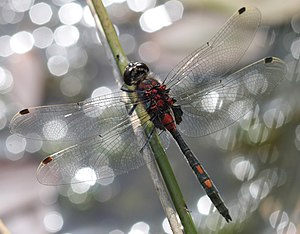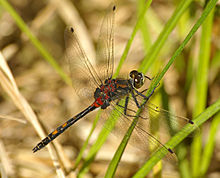Little Moss Maiden
| Little Moss Maiden | ||||||||||||
|---|---|---|---|---|---|---|---|---|---|---|---|---|

Little moss damsel ( Leucorrhinia dubia ), male |
||||||||||||
| Systematics | ||||||||||||
|
||||||||||||
| Scientific name | ||||||||||||
| Leucorrhinia dubia | ||||||||||||
| ( Vander Linden , 1825) |
The little moss damsel ( Leucorrhinia dubia ) is a dragonfly and belongs to the sailing dragonflies (Libellulidae) and is classified in the genus of the moss damsel ( Leucorrhinia ). In 2014 she was named " Dragonfly of the Year " by the BUND and the GdO .
features
The little moss damsel reaches a wingspan of five to six centimeters with a body size of three to four centimeters. The animals have colored dorsal spots on a black background, which are relatively small in this species and barely extend beyond half of the respective segment. Mature males are blood red and black in color. The front of the red spots on the abdomen gradually darken in older specimens. In females, the dorsal spots are usually all white-yellow in color - but there are also so-called homoeochromic or androchromic, i.e. male-like color variants. The light areas are then reddish, apart from the last abdominal spot on the 7th abdominal segment.
The wing marks are black. The anal field of the rear wings is rounded and the discoidal field in the front wing is greatly expanded towards the edge of the wing. At the base of the wings there is a black shadow, which can also be missing on the front wings.
Similar species are the great moss damsel ( Leucorrhinia pectoralis ) and in particular the northern moss damsel ( Leucorrhinia rubicunda ), which often occurs syntopically with L. dubia .
Habitat and way of life
This species can be found on raised bogs and silted areas of bog lakes . Because of its specialization in moorland, it is endangered in Germany, among other places.
The males fly near the shore and like to sit close to the ground on plants, stones or wood. The flight time is from May to August.
The mating starts on the water and ends in the vegetation. The female lays her eggs with rocking movements on floating peat moss . This is done under the guard of the male. The first larvae hatch after three weeks. For the time being they live between the moss plants. They grow very slowly and take two to three years to develop. This is also the case because the bog waters are very acidic and poor in oxygen and there are relatively few food animals in them.
literature
- Gerhard Jurzitza: The Kosmos dragonfly guide . The species of central and southern Europe . 2nd edition Franckh-Kosmos Verlag, Stuttgart 2000, ISBN 3-440-08402-7 .
- Klaus Sternberg: Leucorrhinia dubia (Vander linden, 1825) - Little Moosjungfer . In: Klaus Sternberg, Rainer Buchwald (ed.): Die Libellen Baden-Württemberg, Vol. 2: Large dragonflies (Anisoptera) . Ulmer, Stuttgart 2000, pp. 403-415, ISBN 3-8001-3514-0 .
Web links
- Leucorrhinia dubia inthe IUCN Red List of Threatened Species 2013.1. Posted by: Clausnitzer, V., 2007. Retrieved October 23, 2013.



